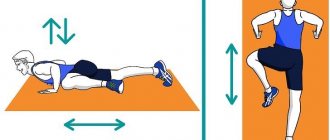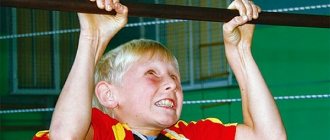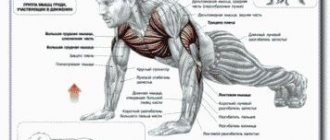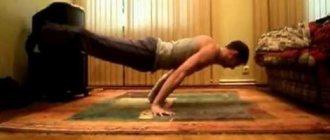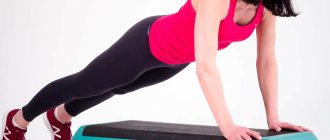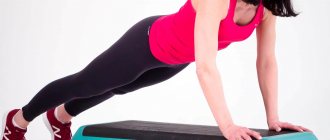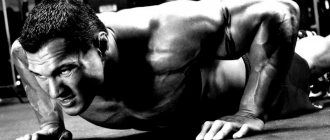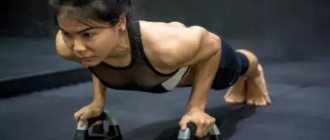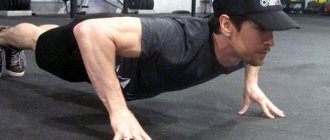Should you force your child to do push-ups?
Many parents are not sure whether push-ups are beneficial for children, so they are in no hurry to do this exercise. Before we teach, let's find out what a push-up is?
This is a basic physical exercise that is performed from an emphasis position lying on outstretched arms. The athlete lifts and lowers the body using the strength of the arms and pectoral muscles, maintaining a straight body position throughout all stages of the execution.
It’s worth teaching your baby to do push-ups, if only because it’s an excellent exercise for strengthening the muscles of the shoulder girdle. In the process of work the following are involved:
- Triceps;
- Pectoral muscles;
- Deltoid muscles;
- Latissimus;
- Quadriceps;
- Press;
- Back;
- Toes and hand joints.
It doesn’t matter who is trying to learn how to do push-ups, a child or an adult, the exercise is equally useful for everyone. A physically active child will definitely grow up strong and strong, strengthen his immune system, improve coordination of movements, and develop many different skills.
Let's talk in more detail about the benefits of push-ups for children?
Area: triceps (and deltoids)
If you want to have powerful arms, you should focus on building your triceps and shoulders rather than being obsessed with big biceps. Conveniently enough, push-ups work the triceps and deltoids the most. These exercises have little effect on your biceps.
You can try doing biceps dips, which can activate the front of your forearm more. But this movement requires even more muscle strength than standard push-ups.
Information. To do biceps push-ups, turn your palm with your fingers towards your legs. And the hands are located as close to the body as possible. Elbows are tucked in, not spread out to the sides. To work your biceps well, you need to touch the floor when lowering.
Benefits of exercise
Before teaching a child to do push-ups correctly, let’s make sure once again that our intention is correct. Just look at the solid list of advantages and feel free to start training!
- The exercise develops a sense of concentration, teaches interaction between the upper and lower body;
- It perfectly strengthens physically, makes the child strong and strong;
- Regular physical exercise strengthens the immune system, affects growth and overall development;
- It has been proven that sports have a positive effect on the mental abilities of children;
- Classes teach self-discipline, endurance, responsibility, develop a healthy attitude towards the hygiene and physiology of your body;
- It is worthwhile for a child to learn to do push-ups because the exercise stimulates the powerful development of the child’s abs, arm and chest muscles, and strengthens joints and ligaments;
- During training, blood flow accelerates, the blood is more quickly saturated with oxygen, which means that every cell receives increased nutrition, which has a positive effect on the overall health of the body;
- Sport has a great influence on the normal socialization of children, which is why every parent should stimulate and encourage their desire to engage in sports.
Please note that if you do not follow the correct push-up technique, all the benefits can easily be reduced to zero results. On the contrary, you risk harming children by overloading joints or muscles. You need to teach not only the correct technique - it is important to do push-ups when you feel good and in a great mood. Also, consult with your pediatrician to see if your child has any contraindications for playing sports.
Do push-ups 100 times a day for a month. This is what will happen to your body after this
A hundred push-ups can replace the gym, develop strength and increase muscle mass.
Buzzfeed editor-in-chief Sam Stryker was inspired by a video in which several of his colleagues underwent a fitness challenge and did hundreds of push-ups a day for a month.
Sam was in good physical shape: he is a competitive swimmer and trains in the pool 4-6 times a week. However, with age, staying in shape requires more work and greater financial investments: the cost of a gym membership, personal trainer or fitness courses.
Unlike the gym, push-ups are free and don't require much time. Sam decided to see if they could be a worthy replacement for the gym and increase strength and muscle mass.
At what age can you do push-ups?
So, we hope we have convinced you that it is worth teaching your child to do push-ups. However, parents who doubt the advisability of this exercise are also, in their own way, right. Meanwhile, the correct position on this issue depends on the age of the child. It is important to do everything on time - and there is also a recommended age threshold for push-ups.
Let's find out at what age a child can do push-ups - we'll give a comprehensive answer to this question:
- From 3 to 6 years old, it is important to focus on flexibility and plasticity, that is, do stretching exercises. With age, a person loses the elasticity of muscles and ligaments, so it is important from childhood to teach a person to love stretching, to form the right foundation;
- From 6-7 years old you can begin to introduce cardio exercises into the complex. Include abdominal exercises, push-ups, squats, running, pull-ups.
- From the age of 10, you can start training with light weights, or complicate the previous complex. You should work under the strict guidance of a trainer; only he can teach you how to do all the elements correctly. The articular-ligamentous apparatus is not yet fully formed; accordingly, the load should be minimal.
- From the age of 12, teenagers can safely use light weights.
Thus, we can conclude that it is worth teaching a child to do push-ups from the age of 6-7, that is, from the moment he enters school. By the age of 10, regular push-ups can be complicated by more complex subtypes (explosive, on fists, with legs raised to an elevated position). A 12-year-old teenager can begin strength training, do push-ups with weights, and practice the most complex variations of push-ups (on one arm, on the fingers).
How to evaluate your starting level
You can evaluate your strength using an initial test. It will help determine your level of fitness, but before you start, be sure to warm up. Warming up will warm up your muscles and reduce the risk of injury.
Performing the test requires precise adherence to technique, but you need to work to your maximum capabilities with breathing tracking. You can stop doing push-ups if muscle pain appears. The results may vary, and further action is required based on the following standards:
- 1-6 push-ups – entry-level program
- 7-10 repetitions is an intermediate level program, we recommend that you start with the beginner program, but from the second week.
- 10 or more – advanced level program
The results are also selected according to age and gender. This helps to conduct a comparative analysis and better understand in which direction to move next.
Features of children's push-ups
Before you teach your child to do push-ups, read the recommendations below:
- It is important to adequately assess the child’s level of preparation. Children with poorly developed muscles should start with lighter variations of the exercise. A gradual increase in load will gradually prepare the muscles for the classic push-up method. In this case, the child will not lose motivation, he will not be disappointed in his capabilities;
- It is possible to teach a child to do push-ups from scratch, but it is extremely important to show him the correct technique. Make sure you really know how to do push-ups;
- Assess how much your child wants to learn how to do push-ups. You should not convince him to work through force. Parents who are looking for information on how to get their child to do push-ups are going down the wrong path from the very beginning. Analyze whether your son is ready for such a load, how dexterous, fast, active he is, what is the speed of his reaction.
- Create a clear lesson program; this is the only way you can teach your baby to do push-ups quickly and technically correctly.
A little motivation
The strongest motivation is the example of your neighbor. If a girl, for example, does more push-ups than her boyfriend, this is already motivation for the guy! They both end up doing push-ups.
If you want to pump up or strengthen your arms, shoulders, chest, but you can’t go to the gym, here’s a good reason to figure out how to learn to do push-ups.
Set yourself a specific goal for the number of repetitions at a time. The goal will not let you stop or go astray. But without a goal, you will give up training in a week or month.
Use push-up variations for beginners to pre-strengthen your muscles, exercise regularly and with pleasure. In this case, the result will not take long to arrive!
Push-up technique
So, let's get down to business directly - here's how to do push-ups correctly for boys 6-12 years old:
- Be sure to do a warm-up. Stretch your arms, body, and do circular rotations to warm up your joints;
- Starting position: lying on outstretched arms, legs resting on your toes. The entire body from head to toe forms a straight line;
- Tighten your stomach and buttocks;
- As you inhale, let your baby begin to bend his elbows, lowering his torso down;
- As soon as the elbows form a right angle, the lowest point is reached, and the chest practically touches the floor;
- As you exhale, lift up using the strength of your arms;
- The parent must ensure the correct position of the body - the back is not rounded, the fifth point is not protruding, and we do not lie with our chest on the floor.
What helps you last
Despite the difficulties, Sam did not miss a single day or a single push-up. In the process, he came up with a few tricks for himself that helped him survive:
- Small quests with rewards. Reward yourself for each approach: do 10 push-ups - you can eat a chocolate bar, another 10 - watch a TV series.
- Reminders on your phone. Set reminders for every hour: “Do tens,” “Let’s do push-ups,” “Do good push-ups,” and so on. This way you won't forget about your fitness challenge and won't leave the whole hundred for the evening.
- Push-ups anywhere. During the day, you can do push-ups in the gym, at home, or at work. At first it may be a little strange to do push-ups in front of your colleagues, but then everyone will get used to it and you won’t care.
- Posts on social networks. Sam posted photos and videos of his ordeal on social media and received many messages from friends and strangers. His example inspired many people to challenge themselves and try doing push-ups for a month. Try publicizing your ordeal on social media: every positive comment will motivate you to continue.
Where to start learning?
Often it is not immediately possible to teach a boy to do full push-ups. Don't worry, everything will work out, just a little later. Try teaching your child easier variations of the exercise:
- Wall push-ups – unload the pectoral muscles. We recommend gradually moving away from the vertical support, eventually moving to the bench;
- Push-ups from a bench - the higher the horizontal support, the easier it is to do push-ups. Gradually lower the bench height;
- Push-ups from the knees - this method reduces the load on the lower back. As soon as you feel that the muscles of the child’s arms and chest are stronger, try full push-ups from the floor.
The technique for performing these variations is no different from the classic one: straight back, bend your elbows to 90°, lower/inhale, lift/exhale. Do each exercise 15-25 times in 2 approaches.
At the same time, to strengthen your muscles, do the plank with your arms outstretched - every day for 40-90 seconds in two approaches.
It is important for children 7 years old to do push-ups correctly, which means pay special attention to eliminating errors in technique. Remember, it’s easier to teach than to relearn, so nip in the bud attempts to cheat: rounding your back, sticking out your buttocks, laying your body on the floor, touching your knees to the floor, etc. Make sure that the child is breathing correctly and do not set the load too high.
Program for Beginners
On training days there should be no other physical activity on the working muscles, but you can do things like squats and deadlifts. If, for example, there is a desire to pump up the “neighboring” muscles (back, shoulders), then the load should not exceed 50% of the maximum. Only under such conditions will it be possible to achieve high results, otherwise the body will deplete its energy reserves without having time to restore them.
If you don’t have enough strength to complete a full approach to the end, you can use drop sets, where the weight lifted is reduced, but the required number of repetitions is brought to the desired level. In this case, after refusing, you can kneel down and continue doing push-ups. I also recommend an article for your reference on how often to train.
First week.
1 workout - 2*20; 2*15; 2*25 – only 6 approaches and 120 push-ups. 2 training - 2*20; 2*17; 2*27 – 6 and 128. 3 training – 2*21; 2*18; 2*28 – 6 and 132.
Second week.
1 workout - 2*23; 2*18; 2*29 – 6 and 140. 2 training – 2*24; 2*19; 2*29 – 6 and 144. 3 training – 2*25; 2*20; 2*30 – 6 and 150.
Third week.
1 workout - 2*24; 2*20; 2*30 – 6 and 148. 2 training – 2*26; 2*22; 2*30 – 6 and 156. 3 training – 2*27; 2*22; 2*32 – 6 and 162.
Fourth week.
1 workout - 2*26; 2*23; 2*31 – 6 and 160. 2 training – 2*28; 2*23; 2*33 – 6 and 168. 3 training – 2*29; 2*24; 2*33 – 6 and 172.
Fifth week.
1 workout - 2*28; 2*22; 2*31 – 6 and 162. 2 training – 4*20; 3*15; 1*47 – 8 and 172. 3 training – 4*21; 3*15; 1*48 – 8 and 177.
Sixth week.
1 workout - 2*29; 2*23; 2*32 – 6 and 168. 2 training – 4*22; 3* 15; 1*50 – 8 and 183. 3 training – 4*23; 3*16; 1*52 – 8 and 192.
The program also involves small “kickbacks”, when the results of one of the following workouts are slightly less than the previous three - this allows the muscles to recover.
It is also possible to perform push-ups from small heights (bars, stands), which will increase the range of movements (lowering), and, therefore, increase muscle growth.
Complicated Variations
As we said above, closer to ten years of age you can move on to more complicated variations of push-ups. Let's look at how to do push-ups correctly for a 10-year-old child and what types of exercises he should be taught:
- With a bang. During the lift, the athlete performs an explosive force, pushing the body upward. At the same time, he must have time to clap before placing his hands on the floor;
- With hands off. Similar to the previous exercise, but instead of clapping, the athlete needs to throw his body up in order to have time to fully straighten and lift his arms off the floor;
- With feet resting on an elevated platform. This condition significantly complicates the classic variation, but it’s definitely worth teaching a child to do push-ups like this. During the execution process, more effort is required, which means that all available forces are mobilized.
- After 12 years, a boy can be taught to do push-ups on the floor using his fists or fingers;
- Particularly difficult variations include handstand push-ups and one-arm push-ups. These techniques require excellent physical fitness of the child.
In conclusion, we would like to emphasize that boys simply have to do push-ups. Every father must teach his child, and best of all, by his own example. This is a basic exercise that demonstrates strength and lays the foundation for a man's future appearance. It is present in all GTO standards and in school curricula. Can be practiced in any sport. Teaching a child to do push-ups on the floor is not at all difficult, especially since the technique is extremely simple. Your main task is to prepare the muscles for the load. If the body and muscles are ready, your child will not have any problems with push-ups.
Daily push-ups - what effect do they give, benefit or harm?
The material was prepared by the site team with the support of our experts: athletes, coaches and nutrition specialists. Our team >>
- Reading time: 5 min.
- The feasibility of daily training
- Push-ups as exercise
- How many times to do push-ups in the morning
- What happens if you do push-ups until you drop?
- Push-ups when passing the GTO standards
- Push-up patterns
- Scheme 1
- Scheme 2
Push-ups are one of the simple and effective exercises with which you can keep your body in shape. Some people follow special programs and track results, while others simply do several approaches every day. Both claim that they get excellent physical activity. So is it really worth thinking about? Let's figure out whether it's possible to do push-ups every day, and what will come of it.
What will you get from the test?
Sam only noticed results from the fitness challenge towards the end of the third week. His muscles continued to ache, but he began to feel stronger and more muscular. In addition, his swimming performance has improved.
buzzfeed.com
Here are a few benefits you'll get by taking the test:
- Muscle mass will increase. The chest, shoulders, abs and back are pumped the most.
- Performance in sports will improve, especially if your hands are actively involved in it. For example, in swimming, strength training.
- Self-esteem will rise. If you pass the 30-day challenge, you will probably be proud of yourself.
Nowadays, everyone is accustomed to quick results and wants to feel the benefits instantly, but this test takes time.
Don't stop and you'll definitely feel like a superhero at the end.
